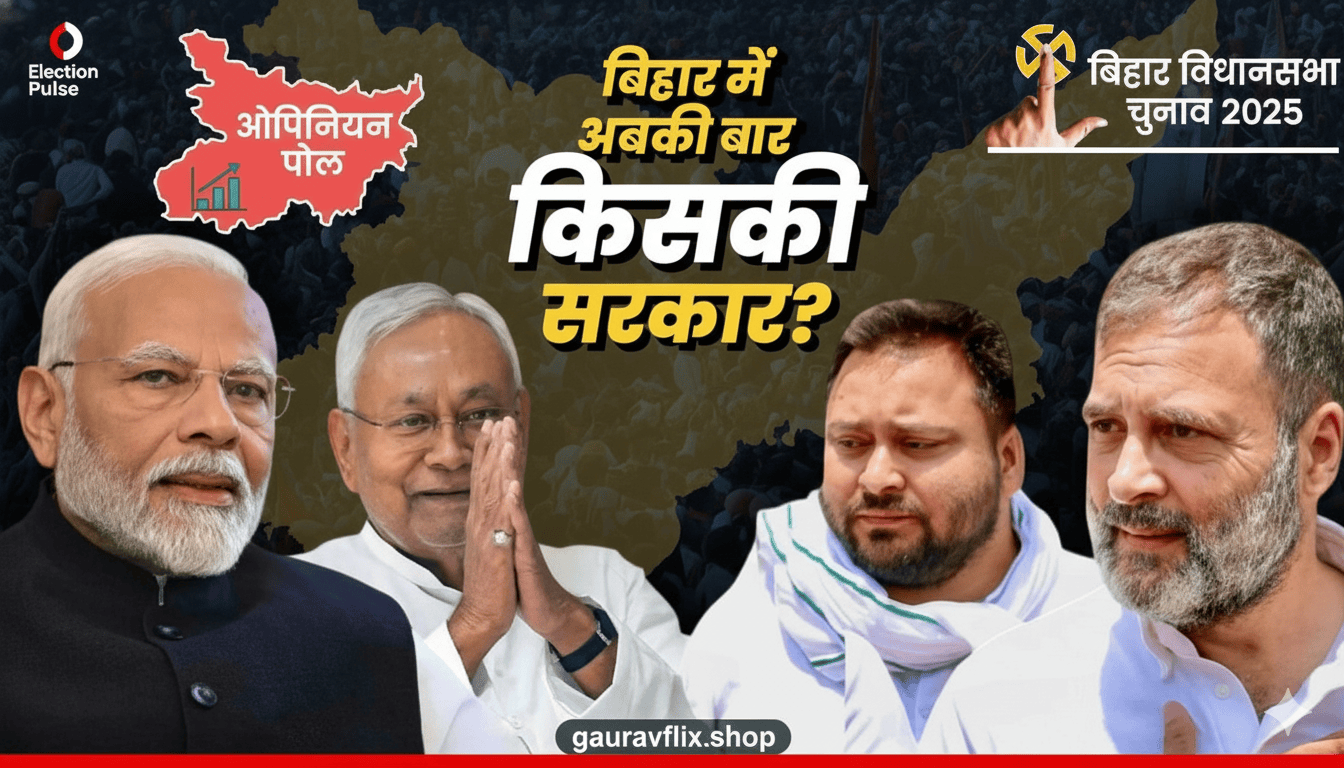Bihar election 2025: what happened, who’s contesting, and what it means
This long-form explainer walks through every practical angle of the Bihar election 2025: the official schedule, how voting will be organised, who the main parties and leaders are, the key issues voters are debating, how demographic and past-result patterns shape outcomes, and what the results could mean for Bihar and national politics. The aim is factual — explain, not persuade — and to answer the likely questions a voter, student, journalist or curious reader would have.
Quick snapshot: Bihar will vote in two phases — November 6 and November 11, 2025 — and counting is scheduled for November 14, 2025. The state has 243 assembly constituencies. The Election Commission announced the schedule and constituency lists in official releases in October 2025.
Why this article matters
State assembly elections are complex events. Beyond dates and names, they involve voter rolls, logistics, a legal framework, alliances, local issues and a national context that shapes strategy. A reader needs:
- Clear, verified facts about dates and the procedure.
- Context on who the contenders are and what they stand for.
- Practical information — how to follow results, how counting works, what questions to ask of media claims.
Official schedule and phases (what the Election Commission announced)
The Election Commission of India (ECI) set the Bihar assembly polling in two phases, with results on a single counting day. The key dates are:
- Phase 1 polling: November 6, 2025.
- Phase 2 polling: November 11, 2025.
- Counting of votes and results: November 14, 2025.
These dates and the constituency breakup were published in government/ECI releases and the Press Information Bureau (PIB). For example, a PIB circular lists the 121 constituencies scheduled for the first phase.
Number of constituencies and the two-phase logic
Bihar has 243 assembly seats. The ECI divided polling stations across two phases for operational reasons — security, resources and to stagger administrative focus. The PIB list shows specific constituencies in Phase 1; Phase 2 covers the rest. Polling station-level arrangements vary by district and are publicly available at the CEO (Bihar) portal once finalised.
Who’s contesting: alliances, major parties and leaders
State-level elections in India are often decided by coalitions. In Bihar, the principal alliances contesting the 2025 polls are the National Democratic Alliance (NDA) on one side and the Mahagathbandhan (Grand Alliance) or rival coalitions on the other. Major parties include the Bharatiya Janata Party (BJP), Janata Dal (United) [JD(U)], Rashtriya Janata Dal (RJD), Congress, and several regional outfits and smaller parties.
By late October–early November 2025, the NDA finalised seat-sharing deals: the BJP and JD(U) were reported to contest roughly equal major blocks of seats, with other alliance partners allocated the remainder — a strategic choice to balance local strengths.
Major political leaders to watch
- Nitish Kumar — long-time JD(U) leader and incumbent Chief Minister (subject to change if a new government forms after counting). He is central to JD(U)’s campaign strategy and coalition choices.
- Tejashwi Yadav — RJD leader and main Opposition face in recent cycles. His appeal among young voters and certain caste/social groups shapes the Mahagathbandhan’s campaign messaging.
- National leaders such as the Prime Minister and central BJP leadership frequently campaign in Bihar; their speeches and visits can shift narratives, especially on national issues and welfare schemes.
Short history: what happened in 2020 and 2024 that affects 2025
The previous Bihar Legislative Assembly election took place in October–November 2020. The National Democratic Alliance (NDA) emerged with a majority then, and Nitish Kumar continued as Chief Minister after post-election negotiations. The 2020 polls were held in three phases; turnout and seat distributions from that election are often used as baseline data for 2025 analysis.
On a related note, the 2024 Lok Sabha (Parliamentary) elections in Bihar — part of the national general election cycle — produced a particular distribution of seats among parties that influences momentum and organisational strength going into the state elections.
Key issues shaping the campaign (what voters consistently cite)
1. Economy and jobs
Unemployment, migration for work, and the creation of local livelihood opportunities are persistent concerns. Parties often promise investment, industrial initiatives, or rural employment schemes. Voters assess these promises through local experience: whether schemes are implemented and whether new jobs actually appear.
2. Agriculture and rural distress
Large portions of Bihar are rural and agrarian; crop prices, irrigation, power supply and access to markets influence farmer sentiment.
3. Law and order and governance
Public security, crime response, and basic governance are recurring voter concerns.
4. Social issues and caste dynamics
Caste remains a significant factor in Bihar’s politics. Parties build coalitions and candidate selections with caste arithmetic in mind.
5. Education, healthcare and local public services
Promises on school improvements, teacher recruitment, primary healthcare, and hospital access appear repeatedly in manifestos and local debates.
Voter rolls, turnout and special preparation
Before an election, the ECI and state CEO update the electoral rolls, correct duplicate entries, and handle appeals. Recent reporting indicated a revision in Bihar’s electoral register with some electors marked ineligible after the statutory review.
Who can vote and how to check registration
Any Indian citizen of voting age who appears on the electoral roll for a constituency can vote. To check registration and find polling stations, voters should use the CEO Bihar portal, the national NVSP portal, or visit local election offices.
How voting and counting work — a simple step-by-step
- Voters go to polling stations between scheduled hours.
- EVMs with VVPATs are used.
- EVMs are sealed and moved to strongrooms.
- Counting of votes happens on November 14, 2025.
Seat-wise and region-wise considerations
Bihar is regionally diverse: the Mithila region in the north, Magadh plateau, and the Gangetic plains all have distinct political patterns.
Examples from recent elections that illustrate how local factors matter
Example 1 — Candidate reputation over party brand.
Example 2 — Caste coalition shifts.
Seat-sharing and the arithmetic of alliances
Seat-sharing is tactical. When two allies contest overlapping constituencies, the vote can split and a third party benefits.
How the media and social networks cover the Bihar election 2025
Expect three parallel flows of information: traditional media, regional reporting, and social media narratives. Verify viral claims by checking official ECI/CEO releases.
Common reader questions (FAQs)
- Q: When exactly will voting and counting happen?
- A: November 6 & 11 for polling; November 14 for counting.
- Q: How many seats are in the Bihar Assembly?
- A: 243 seats.
- Q: Where can I check official candidate list?
- A: CEO Bihar & ECI websites.
- Q: Are EVMs and VVPATs being used?
- A: Yes, per ECI protocol.
How analysts model possible outcomes
They combine past results, voter-roll changes, and alliance dynamics to project scenarios.
Legal rules and Model Code of Conduct
The MCC comes into effect after schedule announcement and governs campaign conduct.
How to follow polling day and results responsibly
- Use ECI’s official updates.
- Cross-check single-source claims.
- Avoid sharing unverified data.
Scenario analyses — hypothetical outcomes
Scenario A: NDA majority
Stable government, policy continuity.
Scenario B: Opposition majority
Policy reorientation.
Scenario C: Hung assembly
Negotiations, smaller parties gain leverage.
Practical checklist for voters
- Carry valid ID.
- Check polling station location.
- Follow ECI guidelines.
Closing analysis — neutral summary
The Bihar election 2025 is a consequential state poll shaped by regional dynamics and issues like jobs and governance.
Key takeaways
- Official polling dates: November 6 & 11, 2025; counting November 14.
- 243 assembly seats; seat-sharing crucial.
- Local issues often decide seats more than national narratives.
- Rely on official ECI sources for updates.



